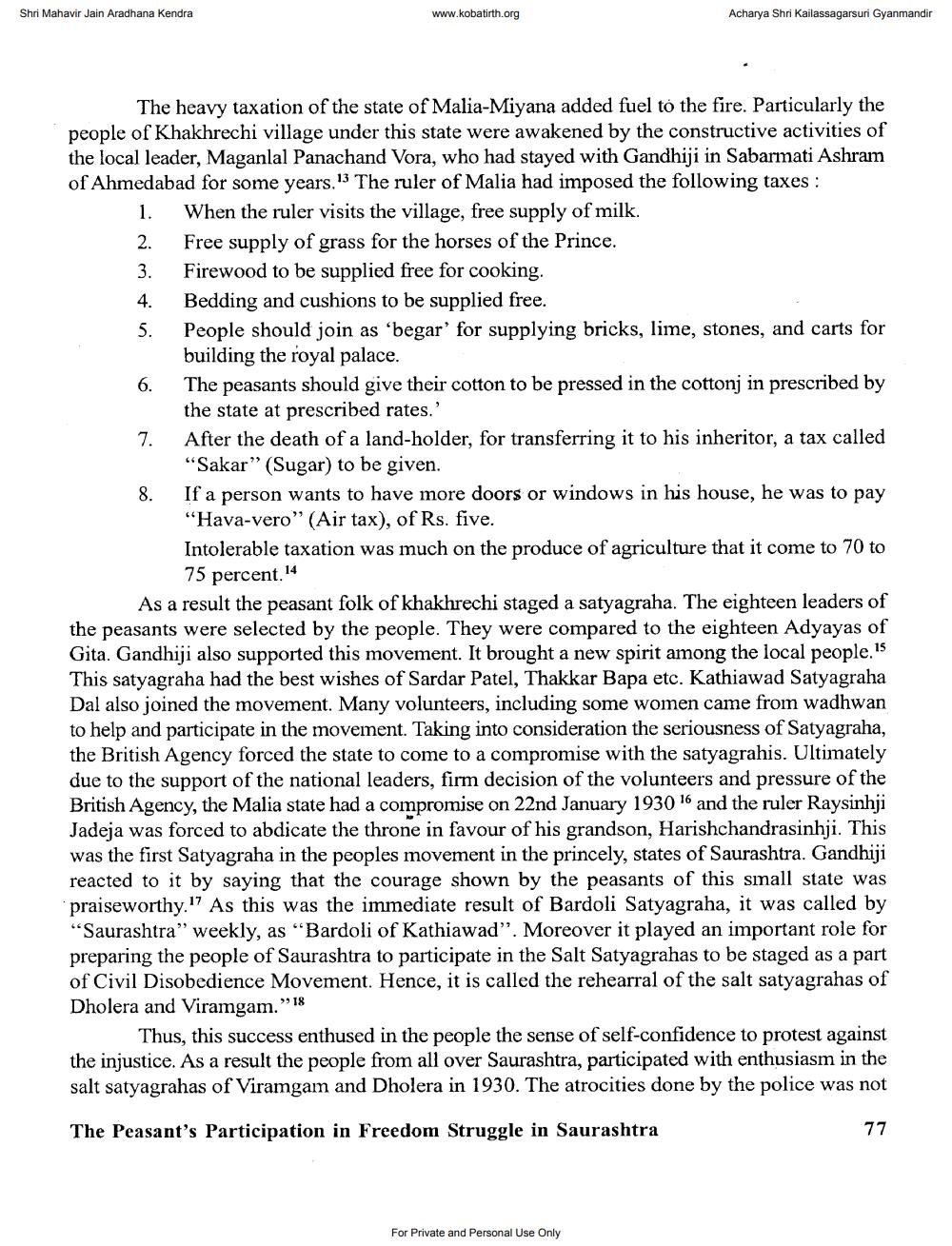________________
Shri Mahavir Jain Aradhana Kendra
www.kobatirth.org
Acharya Shri Kailassagarsuri Gyanmandir
The heavy taxation of the state of Malia-Miyana added fuel to the fire. Particularly the people of Khakhrechi village under this state were awakened by the constructive activities of the local leader, Maganlal Panachand Vora, who had stayed with Gandhiji in Sabarmati Ashram of Ahmedabad for some years, 13 The ruler of Malia had imposed the following taxes :
1. When the ruler visits the village, free supply of milk. 2. Free supply of grass for the horses of the Prince. 3.
Firewood to be supplied free for cooking. 4. Bedding and cushions to be supplied free. 5. People should join as 'begar' for supplying bricks, lime, stones, and carts for
building the royal palace. The peasants should give their cotton to be pressed in the cottonj in prescribed by the state at prescribed rates.' After the death of a land-holder, for transferring it to his inheritor, a tax called
"Sakar" (Sugar) to be given. 8. If a person wants to have more doors or windows in his house, he was to pay
"Hava-vero" (Air tax), of Rs. five. Intolerable taxation was much on the produce of agriculture that it come to 70 to
75 percent. 14
As a result the peasant folk of khakhrechi staged a satyagraha. The eighteen leaders of the peasants were selected by the people. They were compared to the eighteen Adyayas of Gita. Gandhiji also supported this movement. It brought a new spirit among the local people.15 This satyagraha had the best wishes of Sardar Patel, Thakkar Bapa etc. Kathiawad Satyagraha Dal also joined the movement. Many volunteers, including some women came from wadhwan to help and participate in the movement. Taking into consideration the seriousness of Satyagraha, the British Agency forced the state to come to a compromise with the satyagrahis. Ultimately due to the support of the national leaders, firm decision of the volunteers and pressure of the British Agency, the Malia state had a compromise on 22nd January 1930 16 and the ruler Raysinhji Jadeja was forced to abdicate the throne in favour of his grandson, Harishchandrasinhji. This was the first Satyagraha in the peoples movement in the princely, states of Saurashtra. Gandhiji reacted to it by saying that the courage shown by the peasants of this small state was praiseworthy."? As this was the immediate result of Bardoli Satyagraha, it was called by "Saurashtra" weekly, as “Bardoli of Kathiawad". Moreover it played an important role for preparing the people of Saurashtra to participate in the Salt Satyagrahas to be staged as a part of Civil Disobedience Movement. Hence, it is called the rehearral of the salt satyagrahas of Dholera and Viramgam.” 18
Thus, this success enthused in the people the sense of self-confidence to protest against the injustice. As a result the people from all over Saurashtra, participated with enthusiasm in the salt satyagrahas of Viramgam and Dholera in 1930. The atrocities done by the police was not
The Peasant's Participation in Freedom Struggle in Saurashtra
77
For Private and Personal Use Only




